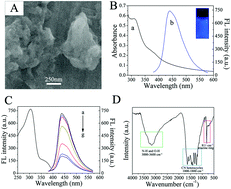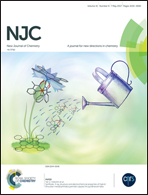On–off–on fluorescence sensing of glutathione in food samples based on a graphitic carbon nitride (g-C3N4)–Cu2+ strategy
Abstract
A novel fluorescence sensor based on a g-C3N4 nanosheet–Cu2+ system has been developed for rapid, sensitive and selective sensing of glutathione (GSH) in food samples. The g-C3N4 nanosheets were used here as a new type of carbon-based nanomaterial with high fluorescence quantum yield and specific surface area. The fluorescence of the g-C3N4 nanosheets was quenched by Cu2+via a photoinduced electron transfer (PET) process. In the presence of GSH, the fluorescence sensor was switched on, which was attributed to coordination of Cu2+ to GSH and the functional groups on the surface of the g-C3N4 nanosheets. Under optimal conditions, a limit of detection (LOD) of 20 nM for GSH was reached over a wide GSH concentration range of 0.05 to 900 μM. Moreover, the proposed sensor shows excellent performance, and has advantages such as low cost, easy preparation, rapid detection and switch-on fluorescence response. The fluorescence sensor was successfully applied for GSH detection in different food samples.



 Please wait while we load your content...
Please wait while we load your content...